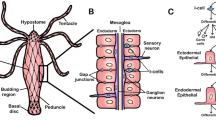Summary
The ultrastructure of the flagellar apparatus of the marine quadriflagellate green algaTetraselmis subcordiformis is described in detail. Special consideration is given to the functional significance of the contractile rhizoplast and also to a complex structure which anchors the flagellar apparatus to the cell membrane and theca. The flagellar apparatus lies at the base of a deep apical depression. Four basal bodies lie in a zigzag row with their long axes nearly parallel. Outer adjacent pairs of basal bodies are structurally linked by a Z-shaped, ribbon-like structure. A striated fiber (transfiber) connects each outer basal body with the inner basal body of the opposite, mirror image pair. A complex system of four laminated oval discs (rhizanchora), microtubule rootlets and fibrous material anchor the flagellar apparatus and rhizoplasts to the plasma membrane and theca. A 4-2-4-2 arrangement of microtubule rootlets is present. Rhizoplasts, which are contractile organelles, branch into five distinct arms and associate with the near outer basal body and each of the four rhizanchora. Rhizoplast contraction is thought to be linked to flagellar activity and may act to alter the direction of motion of the cell.
Similar content being viewed by others
References
Bouck, G. B., Brown, D. L., 1973: Microtubule biogenesis and cell shape inOchromonas. I. The distribution of cytoplasmic and mitotic microtubules. J. Cell Biol.56, 340–359.
Brown, D. L., Massalski, A., Patenaude, R., 1976: Organization of the flagellar apparatus and associated cytoplasmic microtubules in the quadriflagellate algaPolytomella agilis. J. Cell Biol.69, 106–125.
Floyd, G. L., Salisbury, J. L., 1977: Glycolate dehydrogenase in primitive green algae. Amer. J. Bot.64, 1294–1296.
Holwill, M. E. J., 1974: Hydrodynamic Aspects of Ciliary and Flagellar Movement. In: Cilia and Flagella (Sleigh, M. A., ed.), pp. 143–175. New York: Academic Press.
Hyams, J. S., Borisy, G. G., 1975: Flagellar coordination inChlamydomonas reinhardtii: Isolation and reactivation of the flagellar apparatus. Science189, 891–893.
Manton, I., 1965: Some phyletic implications of flagellar structure in plants. Rec. Adv. Bot. Res.2, 1–21.
-Parke,M., Observations on the fine structure of two species ofPlatymonas with special reference to flagellar scales and the mode of origin of the theca. J. mar. biol. Assoc. U.K.45, 743–754.
McLachlan, J., Parke, M., 1967:Platymonas pellucida sp. nov. from Puerto Rico. J. mar. biol. Assoc. U.K.47, 723–733.
Melkonian, M., 1979: An ultrastructural study of the flagellateTetraselmis cordiformis Stein (Chlorophyceae) with emphasis on the flagellar apparatus. Protoplasma98, 139–151.
—, 1980: Ultrastructural aspects of basal body associated fibrous structures in green algae: a critical review. BioSystems12, 85–104.
Moestrup, O., 1978: On the phylogenetic validity of the flagellar apparatus in green algae and other chlorophyll a and b containing plants. BioSystems10, 117–144.
Pickett-Heaps, J. D., 1975: Green Algae: Structure, Reproduction and Evolution in Selected Genera. Sinauer Assoc., Sunderland, Mass.
Pitelka, D. R., 1974: Basal Bodies and Root Structures. In: Cilia and Flagella (Sleigh, M. A., ed.), pp. 437–446. New York: Academic Press.
Ringo, D. L., 1967: Flagellar motion and fine structure of the flagellar apparatus inChlamydomonas. J. Cell Biol.33, 543–571.
Robenek, H., Melkonian, M., 1979: Rhizoplast-membrane associations in the flagellateTetraselmis cordiformis Stein (Chlorophyceae) revealed by freeze-etching and thin sections. Arch. Protistenk. Ed.122, 340–351.
Salisbury, J. L., Floyd, G. L., 1978: Calcium induced contraction of the rhizoplast of a quadriflagellated green alga. Science202, 975–977.
Schnepf, E., Maiwald, M., 1970: Halbdesmosomen bei Phycoflagellaten. Experientia26, 1343–1344.
Spurr, A. R., 1969: A low-viscosity epoxy resin embedding medium for electron microscopy. J. Ultrastruct. Res.26, 31–40.
Stephens, R. E., 1975: The basal apparatus. J. Cell Biol.64, 408–420.
Stewart, K. D., Mattox, K. R., 1978: Structural evolution in the flagellated cells of the green algae and land plants. Bio Systems10, 145–152.
— —,Chandler, C. D., 1974: Mitosis and cytokinesis inPlatymonas subcordiformis, a scaly green monad. J. Phycol.10, 65–79.
Welsch, U.,Storch, V., 1976: Comparative Animal Cytology and Histology. Univ. of Washington Press, pp. 41–47.
Author information
Authors and Affiliations
Rights and permissions
About this article
Cite this article
Salisbury, J.L., Swanson, J.A., Floyd, G.L. et al. Ultrastructure of the flagellar apparatus of the green algaTetraselmis subcordiformis . Protoplasma 107, 1–11 (1981). https://doi.org/10.1007/BF01275602
Received:
Accepted:
Issue Date:
DOI: https://doi.org/10.1007/BF01275602




